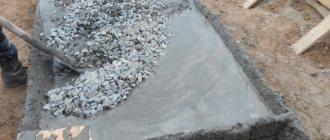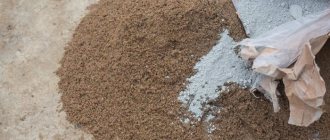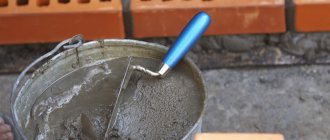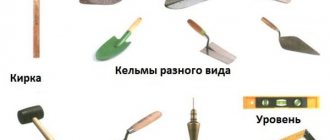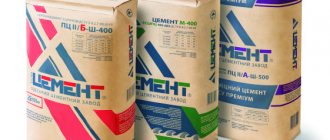- May 13, 2018
Many mixtures are used in construction: concrete for pouring the foundation, mortar for masonry, pouring floors, wall screeds, etc.
The basis of each of them is cement and sand. The properties of the resulting mixture depend on the proportions in which they are added. Sand in construction mixtures is used as a filler: it is cheap, and therefore reduces the final cost of the material. In addition, it makes the solution more durable and increases frost and moisture resistance. Thanks in part to sand, the cement coating does not crack or sag.
The ratio of sand and cement during construction depends on:
- Technical characteristics and purpose of the mixture;
- Quality of cement.
Next, we will consider how much sand needs to be added in various building mixtures.
Brand of concrete and areas of its use
- M100-150 - concrete used for the construction of various non-critical structures that do not perform load-bearing functions. Most often it is used for filling pedestrian paths and sidewalks, since they hardly experience heavy loads;
- M200-250 - often used to cover roads that do not experience heavy loads. In addition, floors and reinforced concrete belts are made from this concrete;
- M300-350 - used in the construction of foundations, floor slabs, roads with heavy loads, staircases, as well as pipes, wells and paving slabs;
- M400-450 is one of the most durable types of concrete. It is used in the construction of high-strength floor slabs, floors in workshops, garages and other facilities where these parts of the building bear a large load. At the same time, with the help of this concrete, foundations and load-bearing structures are created;
- M500 is the strongest concrete grade currently used. It is used in the most critical work, and, unlike other types of this material, it does not lose its properties even in the most difficult operating conditions.
Sand to cement ratio for brickwork
Depending on the brand of cement, its ratio to sand can be different - from 1 to 3 to 1 to 6. The most popular option is the classic mixture, consisting of one part cement to three parts sand. The latter is usually taken from the middle fraction. In this case, the dry ingredients are first mixed until smooth, after which water is poured in. During the mixing process, we achieve such a consistency that the mixture does not flow out when the container is tilted 40 degrees. In this case, the water must be cold (15 degrees) and always clean. Below we present the proportions depending on the brand of cement and other additives:
- Cement-sand mortar with cement grade 500 - 1 part cement to 3 parts sand;
- Cement-sand mortar with cement grade 400 - 1 part cement to 2.5 parts sand;
- Mortar using lime - 1 part cement (500, 400, 300) to 3, 2.5-4 and 3.5 parts sand, as well as 2/10, 1.3/10 and 2/10 parts lime, respectively.
In this case, the amount of water is usually 8/10 parts per 1 part of the cement-sand mixture. In the case of a solution of grade 100, for 1 part of the latter, take from ½ to 7/10 parts of water. The latter solution is precisely used to create brick walls. In the case of mortar grade 115, grade 350 cement is usually used with the appropriate consumption of water and sand. This solution is ideal for laying bricks as part of the external cladding of a building.
Components of masonry mortars
Any mixture for laying bricks always includes three main components. The basis of the solution is the binding components - lime, cement or both of these substances taken together.
- Fine river sand with a particle fraction of no more than 2 mm is used as filler.
- Binders are mixed with the filler and react with chemical additives when diluted in water.
- It is not advisable to take liquid for masonry mortar from dirty and swampy reservoirs, as they may contain excess impurities.
If there are particles of large debris in the water, it must be passed through a filter. Among the additives that improve such characteristics of masonry mortar as adhesion and plasticity, PVA glue can be used at home.
For clean masonry that is not subsequently intended to be plastered, you can prepare a colored solution by adding water-based paint with the desired color to it.
Brand of cement for the foundation and its ratio with sand and crushed stone
The foundation is the most important part of any structure, and the stability, durability and safety of the house will depend on its strength. In this regard, when constructing the foundation, it is necessary to use correctly selected cement. The brand of the latter depends on the load that the foundation part will experience in the future. The grade of concrete means the compressive strength of the hardened composition. The higher the number, the higher the strength, but the higher the price. But when building a foundation, it is contraindicated to skimp on quality.
In the case of concrete preparation, you can use cement grade 100. However, for the construction of the foundation we will use options from M300 and higher. If you want to achieve maximum structural strength, then take the M500, since its price is not much different from the M400. As for the ratio, it is usually 1-3-5 based on cement, sand and crushed stone.
Types of building mixtures
The main component that determines the quality of the solution is the main binder - lime or cement. Using two of these substances or one of them, you can obtain various types of building mixtures for masonry or finishing.
Lime mortars are distinguished by good plasticity and excellent thermal protection properties, but they are used only for the construction of low-rise buildings, as they cannot withstand heavy loads.
- Cement mortars are most often used for working with brick or rubble masonry.
- It perfectly resists high humidity in the underground part of buildings, so it is used for laying strip or block foundations.
- Currently, it is widely used in the construction of buildings of various heights and purposes.
- Solutions based on two binders at once - cement and lime - are used in the installation of structures and finishing work without restrictions.
According to the classification, masonry mortars are also divided into three more types:
- Normal;
- Fat;
- Skinny.
The greater the percentage of binder put into the solution, the more “greasy” it is considered, but this affects shrinkage when the laid mixture hardens and the appearance of cracks.
Accordingly, the skinnier version is plastic, does not shrink much, but is inferior in strength. For ordinary private housing construction, it is recommended to use the formulation of normal masonry mortars.
The ratio of sand and cement for preparing concrete
When erecting reinforced concrete structures, we must accurately calculate the proportions of the components and the grade of cement. Regarding the latter, you can rely on the description given at the beginning of the article, choosing a brand depending on where exactly the mixture will be used.
As for the composition of concrete, in addition to cement, sand and water, crushed stone, gravel and other solid fractions are often used. At the same time, all this can be mixed in very different proportions, depending on the task and the master carrying out the work. As practice shows, the most common combination is: 1 part cement, 4 parts crushed stone, 2 parts sand and ½ part water. But here it is necessary to take into account various additives that give concrete certain properties. If we use them, we will have to act according to the instructions.
Ratio for installing plaster and pouring screed
The amount of water in this case can be very different, depending on the task. In this case, the mixture usually consists of cement and sand, diluted in proportions of 1 to 5.
As for the floor screed, an important factor here is strength, which must have a minimum threshold value of 10 MPa. In this case, it is best to select concrete grade M150, since this parameter in its case is 12.8 MPa. In general, the proportions of the mixture can depend on the following factors:
- The need to conceal various communications;
- The degree of leveling and raising of the surface.
You should immediately decide that when screeding floors in houses and apartments, it is best to use a solution of 100 or 150. In general, depending on the required brand of mortar and cement, the dilution parameters with sand may be as follows:
- Mortar 100, cement 200 – 1 part cement to 3 parts sand;
- Mortar 150, cement 300 – 1 part cement to 2 parts sand;
- Mortar 200, cement 300 – equal parts;
- Mortar 150, cement 400 – 1 part cement to 3 parts sand;
- Mortar 200, cement 400 – 1 part cement to 2 parts sand;
- Mortar 300, cement 300 – equal parts.
Important! Pay maximum attention to mixing the cement mortar for your needs. Incorrect proportions of components can compromise the strength of the poured structure. Especially when it comes to foundations, load-bearing structures or floor slabs.
Basic properties
Components of masonry mortar.
Solutions have their own brands, which can be assigned even to those options that are prepared by hand. It is customary to fix the brand in the following form: for example, M50 is a solution with a compressive strength of 50 kg/cm³. The most widely used options for bricklaying are M10, M25, M50 and M75. Solutions M100 and higher are used in particularly durable structures. You can carry out a strength test yourself - a cube of mortar with a side of 7 cm is subjected to compressive load after 28 days of drying.
An important standardized parameter is mobility. To determine mobility, a cone with an angle of 30º and a height of 15 cm, having a mass of 300 g, is immersed in a fresh solution. It is customary to consider mobility according to the depth of immersion of the cone (in cm) for 1 hour. For laying red brick, the mobility should be no more than 13, and for hollow bricks - no more than 8. When building in warm weather, mixtures with high mobility are recommended.
